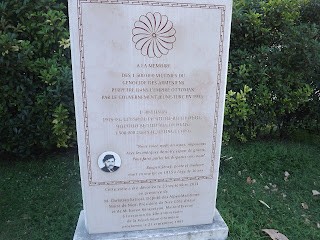NORWEGIANS
IN THE FRENCH FOREIGN LEGION
The French
Foreign Legion is a military service branch of the French Army. The year is
2017. Why do men from different countries enlist in the Legion at all in year
2017? –even Norwegians have left Norway to join the French Foreign Legion. The
Norwegian historian and officer, Knut Flovik Thoresen, has spent at least two
years making research and studies about the history of the Legion -and above
all: The main reasons for joining the French Foreign Legion in year 2017. Let
me turn to his book: “ Norwegians in the French Foreign Legion from 1831 to
2017 “ (Original title: Nordmenn i Fremmedlegionen fra 1831 til 2017).
Let one
of the boys who left Norway bound for France to join the Legion tells his own
story:”…I am waiting for a plane bound for the City of Nice ( The City of Nice
is located in the southern part of France).From Nice I take the train to a town
Aubagne. The Headquater of the French Foreign Legion is situated in Aubagne ….
I am making an attempt to enlist in the French Foreign Legion…”. The boy who wrote the letter to his parents
was twenty-nine years of age when he decided to leave Norway for the Legion. He
was not a teenager. His name is published in the book: Johannes Hartmann who
had served in the Norwegian army already. He wanted a change in life only. The
life in the Legion was no problem for him because he had a military training
already. Johannes Hartmann served the Legion from 2010 to 2015 as a paratrooper
in 2REP. Those who join the Legion for economic reasons are not coming from
Scandinavia but from countries in the Eastern Europe. Former soldiers from
countries in Eastern Europe are paid about 100 EURO monthly at home while in
the Legion they are paid about 2000 EURO monthly. Besides they can be granted
French citizenship after having served the Legion for five years.
When
Norwegian sailors joined the Legion before the Second World the main reason was
not to become a citizen of France. No. Many of the sailors had enjoyed the
party life in bars located in the harbors for too long time. When the ship had
left the harbor without the young sailor, he joined the Legion to make a living
for five years. The stories published about the untrained sailors making a life
in the Legion are stories about unqualified persons who should not have
enlisted at all. It is seldom you read such stories to-day because the official
standard and qualifications of those who want to join the Legion, are high. No
drunken sailor or former criminals are accepted any more- that is past and
history.
The life of
the Legion was a risky life and not a romantic life: So far the official number
of men killed during the service in the Legion is sixteen. Sous-lieutenant
Oscar Tønsberg from Christiania(Oslo)
was killed in Mexico close to Montealo in December 1866. Truls Andersen was
killed in Mexico in December 1866 too.
Reading the
stories about the young boys who had survived the time in the Legion create a
wish for more detailed information. Maybe the writer of the book is already
making preparations for another book contenting more facts about the life of
the former legionaries?


















































